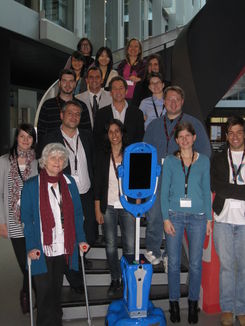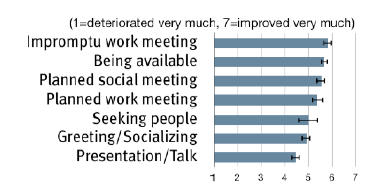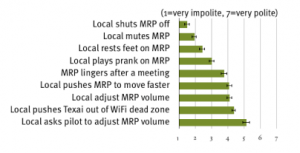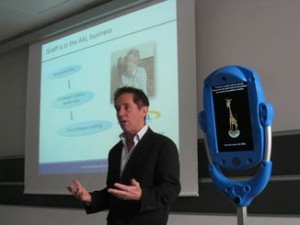
Gathered around the Giraff
So, as I was drafting up my links, I realized I had not dove into some of the workshops that happened at HRI 2011 – especially one I found quite interesting: Social Robotic Telepresence. The Social Robotic Telepresence workshop schedule seems to have heavily focused on the use of RPSes in elder care, but one of the sessions was particularly interesting: Evaluation of Social Robotic Telepresence.
In this session, three papers were presented. One, by Kate Tsui who we have mentioned before and listed in our Remote Presence Links yesterday closed off the session. The first two are ones I wanted to bring up today.
Effectiveness of RPS in Elder Care
The first paper called “Towards Evaluation of Social Robotic Telepresence based on Measures of Social Richness and Spatial Presence (pdf)” is a discussion on how the use of the Giraff RPS may or may not be effective in elder care. Of the three metrics that were tracked, experimentally they determined that:
- the caregivers (or pilots) had a very realistic sense of the reality the RPS was in (IMO meaning they knew where everything was, how high everything was, what was in the way, etc)
- the caregivers and the elders (or participants) were better able to communicate with each other, and
- both the caregivers and the elders did not think they could emotionally influence the other as effectively (my interpretation) as they could in person.
As a user of over five RPSes and having many experiences working with them in a business situation, I can attest to each of these points personally.
“Now I have a body!”
The second paper is from Min Kyung Lee from Carnegie Mellon University and Leila Takayama from Willow Garage entitled “‘Now, I have a body’: Uses and social norms for mobile remote presence in the workplace” is a personal favorite. In this paper, the Willow Garage Texai is used as the Mobile Robotic Telepresence (MRP) or RPS in our lingo. Unfortunately, you have to download the entire proceedings to get it (UPDATE: the link for the individual one is NOW working).
To say this paper is meaty is an understatement. This paper is a rich treasure-trove of insights into the issues and futures of remote presence. Some of these insights include:
- Factors that affect the perceived benefits included locals prior familiarity with pilots (did they know them) and whether or not the RPS was dedicated to one person or was a community resource.
- Having an RPS increased the overall amount of communication between pilots and locals (or participants) and did not significantly reduce other means of communicating (e.g., phone, text, IM, etc.) – “It isn’t so much about transitioning communication as it is increasing communication.”
- Informal communication benefited the most and all other activities showed a marked improvement.

Improvements all around
- By having an RPS, the remote workers were able to create a social bond by being more present in the local office, demonstrating commitment. And if the local did not already know the pilot, then they would get a marginally better sense of presence of the pilot.
- By having the RPS, pilots were able to capture attention and cause impromptu meetings to happen – instead of the standard process of having to have the locals initiate the meeting in a teleconference room.
- The building of connections were greatly enhanced by the RPS. In one passage in the paper, it quotes (emphasis mine):
Our observation and interviews also showed that the MRP’s rich modalities—user controlled movement, its approximate
human scale body, and audio and video communication all seemed to increase the social presence of remote pilots, which led to relatively fluid social interaction among local coworkers and remote pilots. Experienced pilots used the mobile base to socially signal when they wanted to talk and to whom they were listening by positioning and orienting the MRP system. Many locals reported that meeting someone for the first time via the MRP was more natural than other communication media alternatives. One
local coworker mentioned meeting the remote person for the first time: And he just rolls up to my office door and says, “Hi,” which is
great. If he had hopped on my computer screen through Skype, that would have been very awkward. Being able to be physically present in a social milieu allowed a relatively natural social interaction between the MRP and others. - Challenges of the RPS/MRP included manual driving from one location to the next, walking and talking at the same time (trying to keep eye contact while navigating was taxing), and connectivity issues could be embarrassing to the pilot.
- While gaze matching (looking one in the eye) and head turning were a “problem” with the RPSes. they were not show-stoppers for the pilots.
- New social usage norms came up – which began to show how people reacted to things that would normally be okay with other forms of technically-assisted communication.

Would you do this to a person?
- People began to start calling the RPS the person embodying the system – which flexed various social conventions (is it alright to lean on the RPS? To put my feet on the RPS?)

Photo credit: Lorenza Tiberio
These and other insights are findable in the paper at the Workshop site. A definite engrossing read for the future of remote presence.
My biggest disappointment: wish I had gotten a chance to listen to Stephen von Rump discuss the designing of the Giraff.





